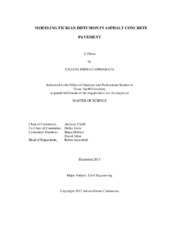| dc.description.abstract | The objective of this study is to determine whether exposing an asphaltic roadway to standing liquid water for a duration of twelve hours will cause sufficient moisture penetration to induce deterioration of the roadway. A mathematical model based on mass conservation was applied for the purpose of predicting the diffusivity of moisture into the roadway. The result was then used in a computer simulation to model the temporal and spatial distribution of moisture.
In order to execute the simulation, it was necessary to determine the diffusivity of moisture in asphalt concrete. To this end, an experiment was conducted to find the change in mass over time of laboratory samples of asphalt concrete exposed to water on only one face. The procedure for executing this experiment was developed and explained as a part of the research program. The experimental data were shown to be statistically valid, and the resulting diffusivity of moisture in asphalt concrete was found to be 5.976E-5 cm^2/hr.
This value was applied within a finite element code for modeling Fick’s Second Law to predict the spatial and temporal distribution of moisture within a representative roadway. Three scenarios were modeled: an undamaged asphalt concrete roadway, an asphalt roadway with a partial crack through the asphalt layer, and an asphalt roadway with a crack extending entirely through the asphalt roadway and into the base layer. On the basis of the results predicted by the model, it was concluded that an asphalt roadway is likely to experience significant damage due to moisture penetration over a twelve hour period only in the case where the crack runs entirely through the asphalt concrete layer and into the base material. This conclusion is based on the extremely small value of experimentally observed diffusivity of moisture in asphalt concrete. | en |


